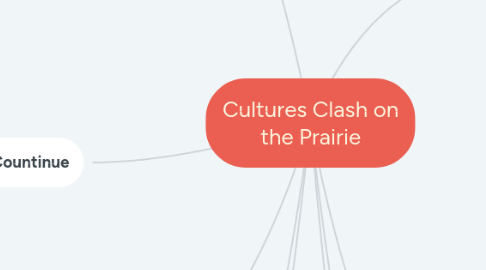
1. The Government Restricts Native Americans
1.1. Effect of more settlers to move westward
1.1.1. Government's policy affect native Americans that lived on the plains.
1.1.2. Government created clear boundaries for each tribes.
1.1.2.1. Native American ignored the government
1.1.2.1.1. Tragic results
1.2. Terms
1.2.1. Treaty of Fort Laramie : Treaty that Sioux agreed to live on a reservation along the Missouri River, signed on April 29th, 1868.
1.2.2. Sitting Bull : Leader of the Hunkpapa Sioux.
1.2.3. George A. Custer : A cavalry commander, in his last battle, he led 210 men to their death. - 1874 reports much gold in Black Hills. - Gold rush begins on Sioux treaty land.
2. Bloody Battles Countinue
2.1. Red River War
2.1.1. Warriors been hung, women and children been brought away
2.2. Gold Rush
2.2.1. Miners search for the Black Hills for gold
2.2.1.1. Reported by George A. Custer
2.2.1.2. Sioux chief appealed to government officials vainly
2.3. Custer's last stand
2.3.1. Colonel Custer and his troops reached Little Bighorn River, native American ready for them
2.3.1.1. Lead by Crazy Horse, Gall, and Sitting Bull
2.3.1.1.1. Crushed Custer's troops
3. The Government Supports Assimilation
3.1. Many people supported assimilation
3.1.1. To make Native Americans give up their beliefs become part of American culture
3.2. The Dawes Act
3.2.1. Americanize the Native Americans
3.3. Terms
3.3.1. Assimilation : Making someone or a group to become part of the society, culture.
3.3.2. Dawes Act : An act to provide for the allotment of lands in severalty to Indians on the various reservations.
3.3.2.1. - Americanize natives - Give land to individual Native Americans - Sell rest of the lands to settlers - Money for farm tools and education - In the end, Native American receive only ⅓ of land and no money.
4. Cattle Become Big Business
4.1. Cowboys appears
4.2. More demand for beef
4.3. Terms
4.3.1. Longhorns : Cattle born with long horns.
4.3.2. Chisholm Trail : The trail that used in post-civil war, sending cattles from San Antonio, Texas, through Oklahoma to Kansas.
5. The End of the Open Range
5.1. Cattle herds became big business
5.2. Open west era was over
5.2.1. People started to use barbed wire (invented by Illinois farmer Joseph F. Glidden) that is cheap and easy to use.
6. The Culture of the Plains Indians
6.1. Terms
6.1.1. Great Plains : The grassland extending through the west-central portion of the US.
6.2. Most of the Native American lives on the Great Plains. (West)
6.3. Living style
6.3.1. Settled
6.3.1.1. Planted crops
6.3.2. Nomadic
6.3.2.1. EX : Sioux and Cheyenne
6.3.2.2. Gathered wild foods hunted buffalo.
6.4. Spanish brought horses to New Mexico (1598)
6.4.1. Effect of horses
6.4.1.1. People can be able to travel further.
6.4.1.2. People can be able to hunt more efficiently.
6.4.1.3. mid-1700s, people left their farms
6.4.1.3.1. hunt buffalo.
6.4.1.4. Causing more wars
6.4.1.4.1. One tribes cross other tribes' hunting area.
6.4.1.5. Give Native Americans speed and mobility.
6.5. Family life of Native American
6.5.1. Small extended family groups
6.5.2. Young men trained to be hunters and warriors.
6.5.3. Women helped butcher the game and prepared the hides that the men brought back to the camp
6.5.4. Men and women that showed particular sensitivity to the spirits became medicine men or women.
6.5.5. Leader of the group ruled by counsel not force.
6.5.6. No one can dominate the group.
7. Settlers Push Westward
7.1. Native Americans had lose their rights to the land because they did not settled down.
7.1.1. Migrants sent westward to claim those lands.
7.2. Gold
7.2.1. Discoved in Colorado in 1858
7.2.1.1. Brought thousands of miners to the area.
7.2.1.2. People started to go westward to try their luck of getting a better life.
7.2.1.3. Miners started to originated camps on Native American land.
8. The battle of Wounded Knee
8.1. Sioux continued to be poor and full of diseases
8.1.1. Seventh Cavalry took 350 starving Sioux to Wounded Knee Creek.
8.1.1.1. Soldiers opened fire with deadly cannon
8.1.1.2. Unarmed Native Americans dead
8.1.1.3. End of Indian wars
8.2. Terms
8.2.1. Battle of Wounded Knee : The battle took place on December 29, 1890 near Wounded Knee Creek in South Dakota.
9. A Day in the Life of a Cowboy
9.1. Cowboys have hard lives when caring those cattle
9.2. Terms
9.2.1. Long drive : Overland transport.
